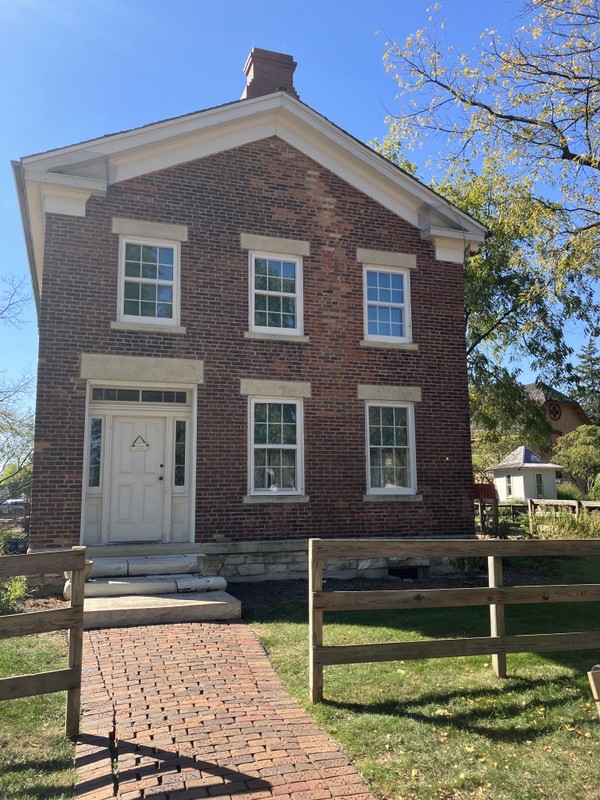Halfway House
Introduction
Text-to-speech Audio
The Stanley family built this farmhouse in 1843. All the early settlers needed to grow their own food in order to survive. Without proper food preservation, the food they spent so much time and effort growing would be lost or even worse, make a person deathly ill. Most farms had a smokehouse—a masonry structure similar to the one you’ll find behind the Halfway House, where a fire could be built on the dirt floor and kept smoldering for up to two weeks. The smoke would slowly cook the meat and infuse it with flavor. Also behind the Halfway House, there is a milk house. Milk houses were used to store milk before transportation to a creamery in the early 20th century. While this milk house was built adjacent to a barn, earlier milk houses were built on top of a creek or a river to keep milk cool. In the 1800s and early 1900s, Naperville was a dairy town, with cows outnumbering people for several decades. The Halfway House also had a root cellar. Cellars, like the one you’ll find on the northwest side, were the ideal place to store the harvested food like fruits and vegetables, along with dairy products and preserved meat. The underground location provided insulation, keeping food cool in summer and preventing it from freezing in the winter. Helena Zentmyer Wackerlin gave it the nickname "Halfway House," based on her childhood memory of the house as the halfway point of the two-hour carriage ride between her family's home in Naperville and her grandparents' home in Aurora. The Halfway House was moved to Naper Settlement in 1975 from its original location on Aurora Avenue, west of Route 59, near the Fox Valley mall.
Images

Backstory and Context
Text-to-speech Audio
Urbane Stanley moved from Vermont to Naperville in 1837, where he lived as a farmer. His land not only provided rich red clay soil to grow crops, but Stanley also used the clay to make the red, sunbaked bricks used to build this house, later nicknamed the “Halfway House”, in 1843. Although the home exhibits some elements of Greek Revival architecture, the architecture of the Halfway House is more commonly associated with folk architecture. Unlike other architectural styles that came and went, folk homes provided shelter with little regard to changing fashions. Homeowners typically built these homes themselves using materials found close to their site, sometimes with the help of local craftsmen. Families passed folk building traditions down through generations, resulting in little variation of the style. Its similarity in design to other buildings at Naper Settlement suggests that Naperville’s early residents possibly shared building traditions with each other. Originally standing halfway between Naper’s Settlement and Aurora, 12 miles west, the house soon became a familiar landmark dubbed the “Halfway House” by a young traveler, Helena Zentmyer, as she often passed between the two towns. The location of the house on the main thoroughfare also made it a resting spot, a place to get a drink of water before the next leg of the trip. Recognizing the building’s rich history, Helena Zentmyer purchased the home and donated it to the Settlement. The Halfway House was relocated to Naper Settlement in 1975.
All the early settlers needed to grow their own food in order to survive. Without proper food preservation, the food they spent so much time and effort growing would be lost or even worse, make a person deathly ill. Most farms had a smokehouse—a masonry structure similar to this one, where a fire could be built on the dirt floor and kept smoldering for up to two weeks. The smoke would slowly cook the meat and infuse it with flavor. This smokehouse came from Max Gartner’s farm in south Naperville, where it had been in use for a hundred years. The walls are double thick brick, which support a limestone slab ceiling most likely hauled from one of the local quarries. Cellars, like the one on the northwest side of the Halfway House, were the ideal place to store the harvested food like fruits and vegetables, along with dairy products and preserved meat. The underground location provided insulation, keeping food cool in summer and preventing it from freezing in the winter. The milk house behind Halfway House dates to the early 1900s and was used to store milk prior to transportation to a creamery. Although this milk house was located adjacent to a barn, earlier milk houses were typically located on top of a creek or river to keep the milk cool. Naperville had many dairy farms in late 19th and early 20th centuries with cows outnumbering people for several decades. The Milk House comes from the Maple Knoll Dairy Farm which was originally owned by the Bauer Family and bounded by Ogden Avenue, Washington Street, and I-88. The Milk House moved to Naper Settlement in 2019.
To make getting water a little easier on the farm, windmills could be hooked up to water well pumps. Rather than a person spending hours pumping the lever up and down to get water, the windmill could do the work instead. As the windmill blades spun, it would cause a vertical bar to move up and down. This bar could attach to the pump and act as the lever, providing a consistent stream of water into a barrel, trough, or other storage tank.
